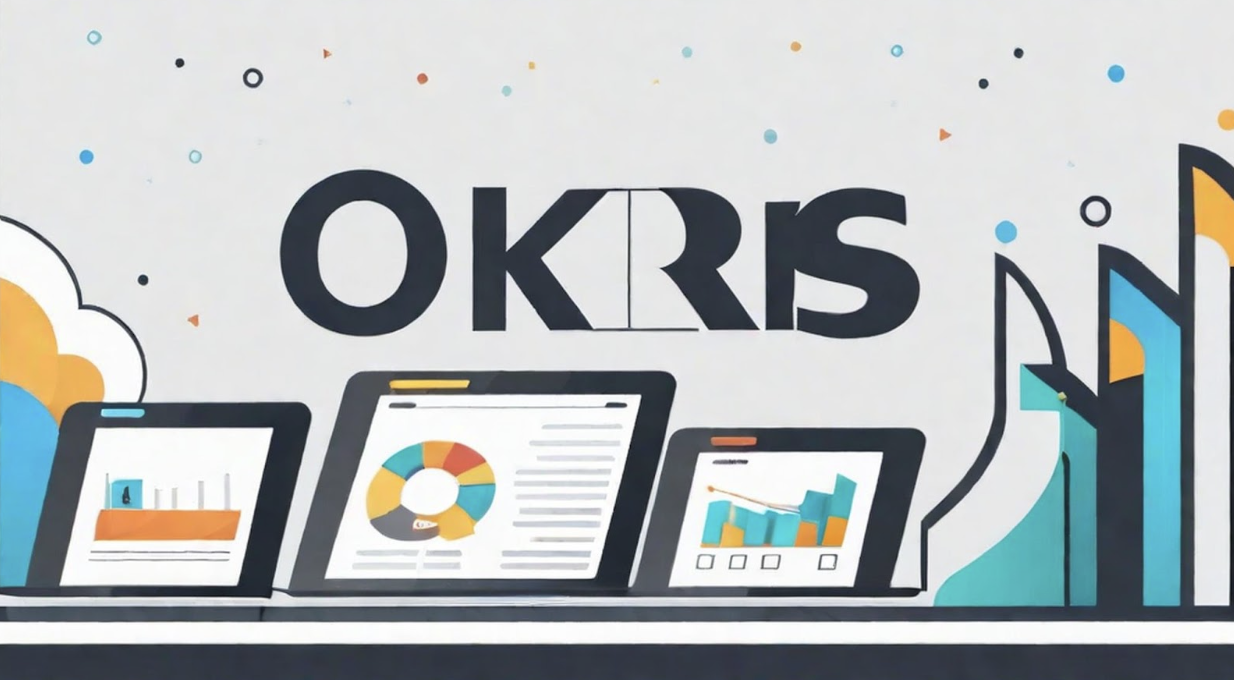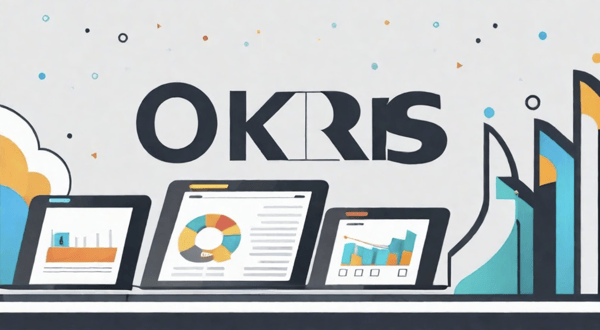Today we're going to focus on a popular goal-setting methodology known as OKR. Introduced by John Doerr, the OKR framework allows a team to set goals and track them accordingly. Under this framework, goals and objectives are aligned with the day-to-day activities. Read on to find out how this goal-setting methodology works and examples for you to gain inspiration.
Understanding objectives and key results: A definition
Objectives and Key Results (OKRs) are used by individuals and teams to collaboratively set goals and obtain measurable results. These goals are ambitious and daunting to achieve. OKRs allow individuals and teams to track progress, foster a sense of synchrony, and support engagement when working with measurable goals.
The OKR framework explained with examples
Let’s look at an example of ‘objectives and key results’ for a marketing team.
Objective: Increase Brand Awareness
Key Results:
- Achieve a 20% growth in social media followers:
- increase the number of followers on all major social media platforms from the current count.
- Generate 50% more website traffic from organic search:
- improve SEO strategies to increase organic traffic to the company website.
- Secure media coverage in at least three major industry publications:
- develop and execute a PR strategy to get featured in prominent publications.
- Launch a successful influencer marketing campaign with a reach of 1 million impressions:
- collaborate with relevant influencers to promote the brand and achieve the targeted impressions.
Guidelines for Crafting an OKR
The easiest approach to crafting an OKR is writing one objective at the top, and several supporting key results beneath it. Alternatively, you can write your objective and key result as a statement.
For example:
I will (Objective) as measured by (Key Results).
I will enhance customer satisfaction as measured by:
- achieving a net promoter score (NPS) of 70.
- Reducing customer support response time to 12 hours.
- increasing followers on social media platforms by 20%.
The evolution and background of OKR methodology
The OKR methodology was first introduced in 1954 when the Management by Objectives (MBO) was introduced by Peter Drucker. Later on, the MBO framework was further advanced by Andrew Groove in 1968 as he joined Intel. Years later, John Doerr also became a part of the same organization and grasped the fundamentals of OKR.
Doerr transitioned towards Google Inc. during the later years of his career and introduced OKR to the founders over there. The approach continues to remain integral to Google’s success today. Since that influential adoption, the appeal of OKRs has steadily surged. Organizations across the globe are now widely embracing and leveraging this goal-setting methodology.
Different categories of OKRs
There are three distinctive categories of OKRs.
Contrasting committed OKRs with aspirational OKRs
Committed OKRs, true to the name, are all about commitments. A committed OKR looks forward to having a passing grade when it is graded at the conclusion of a cycle.
Aspirational OKRs are also known as ‘moon-shots’ or stretch goals. It goes without doubt that the journey to an aspirational OKR is going to be an uncharted territory since it has not been practiced before. Aspirational OKRs are usually long-term in nature, and will often go beyond the OKR cycle.
OKRs for learning and development
Learning OKRs focuses on obtaining new and unexplored knowledge as the key outcome for a cycle. When the team isn't too certain about its next steps, a learning OKR can be set to seek solutions: "What is the most crucial thing that I want to learn in the next 60 days?" Having a learning OKR like that allows them to create a relevant OKR, whether aspirational or committed in the upcoming cycle.
Comparing top-down and bottom-up OKRs
Top-down OKRs are the objectives defined by the senior leadership of the organization. These ‘cascading’ objectives are channeled downwards towards various departments, managers, and the workforce. Everyone within the organization takes due ownership of the key results linked to the top-down OKRs.
Top-down OKRs are useful to achieve goals and objectives across the organization where teams work with high motivation and ambition. On the other hand, bottom-up OKRs are created by employees and flow upwards towards the higher tiers of management. These are significant in terms of individual motivation, fostering creativity and innovation, and allowing employees to take ownership.
Implementing personal OKRs
If you wish to utilize the OKR methodology in your routine, non-work-related activities, you can simply research and read an individual’s experience with using ‘personal’ OKRs.
Effective change management is valuable when implementing OKRs as it ensures smooth transitions and fosters a culture receptive to setting goals. Using change management, the OKR framework can be successfully integrated into the organization’s practices.
Advantages of implementing OKRs
There are numerous advantages of implementing OKRs in the business:
Clear and targeted implementation of goals
When teams implement OKR, they target the tasks that are likely to have the greatest impact on business. Expectations from teams and employees are crystal clear; they know what they need to know. As a result, resource allocation is effective and tasks are prioritized wisely. Using precisely measurable outcomes, the OKR methodology helps everyone remain focused and determined toward the main goal.
The 'Jobs to be Done' framework is essential in OKR implementation as it helps identify and address the specific needs and challenges of users, guiding objective-setting by focusing on outcomes that truly matter to customers and stakeholders.
Putting strategy first
The OKR methodology prioritizes tasks, which further allows everyone in the team to recognize and openly communicate the key strategy. As a result, everyone’s efforts and activities are synchronized closely with the ultimate goal of the organization.
Continual improvement
OKRs are not expected to be left behind. Instead, they support ongoing learning. By regularly checking on progress, OKRs ensure that organizations are continually enhancing, refining, and accomplishing their goals by making tweaks to the OKRs wherever needed.
Enhancing employee motivation and engagement
When the team is engaged with a clear and coherent purpose, they are more likely to be more productive and efficient. That’s what OKR does: communicates the big picture to the workforce in a tangible approach. Using this, employees are conveniently able to visualize their contributions to the achievement of the goal. They remain motivated and productively engaged, thereby resulting in improved performance.

Typical errors in OKR implementation
As with other methodologies, the OKR also requires practice. Here are some common errors to avoid if you’re trying the OKR technique for the first time.
Confusing OKRs with KPIs
It should be noted that OKRs are completely different from key performance indicators (KPIs). OKRs are used for the transformational goals of the organization which are substantial in nature. KPIS, on the other hand, focuses on the usual business activities such as the ongoing processes and performance of teams, departments, and employees.
Failure to align OKRs with company strategy
The strategies define the organization’s priorities, and what direction they want to proceed in. When OKRs are not closely aligned with the strategy, it is rather difficult to make sure that most of the efforts are concentrated on areas that are most significant.
Focusing on outputs rather than outputs
The crux of the OKR methodology lies in its shift in the mindset from ‘what has to be done’ to ‘what needs to be achieved’. Try to avoid this error when you start using OKRs. Establish your outcome, stay close to the big target, and untap your achievements.
Assessing OKRs: The grading system
As explained above, OKRs are continually tracked to check the progress and graded when the OKR cycle ends. There are a number of approaches to grade and score the objectives and key results.
One of the simplest grading systems is known as the ‘Andy Grove’ method, which entails a ‘yes’ or ‘no’ format. In other words, the system states whether the OKR was met or not.
A slightly more detailed version of the Andy Grove method is the use of colors such as red, yellow, and green to indicate different outcomes.
- ‘Red’ means the OKR was not met.
- ‘Yellow’ indicates some progress.
- ‘Green’ means the OKR was fully achieved.
The grading strategy implemented by Google, however, is the most detailed. It uses a percentage scale and provides a numerical score for every key result at the end of the cycle. The overall score is calculated at the end by averaging the scores.
Concluding Remarks
Harvestr stands out as an all-in-one management platform, streamlining the implementation of OKRs for your organization. This seamless integration empowers your team to effectively set, track, and achieve objectives and key results, making Harvestr an indispensable partner in driving efficient and impactful management strategies.
Frequently Asked Questions
What is an example of objective and key results?
Objective: Increase Customer Satisfaction.
Key Results: Achieve a Net Promoter Score (NPS) of 75, reduce customer support response time to 6 hours, and launch a customer product feedback portal with a 40% participation rate.
These measurable outcomes align with the broader goal of enhancing customer satisfaction.
What are the objectives and key outcomes?
Objectives are clear, overarching goals that define a desired outcome. Key results are specific, measurable milestones that indicate progress toward achieving the objective. Together, objectives and key results (OKRs) form a goal-setting framework, guiding organizations to articulate and measure success in a structured manner.
How do you fill objective and key results?
To fill objectives and key results (OKRs), first define a clear objective—your overarching goal. Then, outline specific, measurable key results that, when achieved, demonstrate progress toward the objective. Regularly review and adjust as needed to keep the goals aligned with organizational priorities and evolving circumstances.

